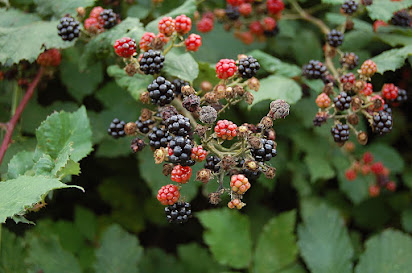The Environmental Impact of Himalayan Blackberries in Vancouver, Canada
Introduction:
Himalayan blackberries (Rubus armeniacus), originally brought to North America for their large, delicious fruits, have since proven to be a formidable invasive species, causing significant environmental harm. In areas like Vancouver, Canada, these aggressive growers have overrun native vegetation, disrupted ecosystems, and imposed challenges for local flora and fauna. This article explores the detrimental environmental effects of Himalayan blackberries in Vancouver.
1. Displacement of Native Species:
One of the most significant environmental impacts of the Himalayan blackberry in Vancouver is the displacement of native plant species. With their fast growth rate and sprawling, thorny thickets, Himalayan blackberries easily outcompete native plants for light, space, and soil nutrients. This displacement can drastically reduce the diversity of plant life in Vancouver's natural habitats.
2. Disruption of Ecosystems:
By outcompeting and displacing native plants, Himalayan blackberries disrupt the balance of local ecosystems. Many insects, birds, and animals rely on native plants for food and habitat. When these plants are displaced by invasive species like the Himalayan blackberry, the wildlife that depends on them can suffer. This disruption can lead to decreased biodiversity and negatively impact the overall health of the ecosystem.
3. Creation of Impenetrable Barriers:
Himalayan blackberries form dense, thorny thickets that can create physical barriers in the environment. These barriers can block access to water sources for animals and inhibit the movement of smaller wildlife species. In addition, these impassable thickets make it difficult for native plant species to reestablish in areas overtaken by blackberries.
4. Increased Soil Erosion:
While at first glance, the thick root network of Himalayan blackberries might appear to stabilize soil, the plant's dominance can lead to increased soil erosion. As the blackberries overtake an area, they crowd out other vegetation, including plants that play a significant role in holding soil in place. This issue can be particularly problematic in riparian areas, where soil stability is critical.
5. Impacts on Water Quality:
The rampant growth of Himalayan blackberries, particularly along waterways, can impact water quality. As the blackberries replace native plants along riverbanks and streams, the lack of plant diversity can negatively affect the health of these water bodies. Additionally, the aforementioned increased soil erosion can lead to higher sediment levels in waterways, disrupting aquatic habitats and potentially impacting local fish populations.
6. Fire Risk:
Finally, the thickets formed by Himalayan blackberries can pose a fire risk. The dead canes and leaves that accumulate within the thickets provide a ready source of dry, flammable material. In the event of a fire, these blackberry patches can fuel the flames, increasing the fire's intensity and speed.
Conclusion:
While the fruits of the Himalayan blackberry might be enjoyed by many in Vancouver, the environmental impact of this invasive plant is cause for serious concern. From the displacement of native plant species to disruption of local ecosystems, increased soil erosion, impacts on water quality, and elevated fire risks, the environmental harm caused by Himalayan blackberries is far-reaching. It is crucial for Vancouver and its residents to take action in controlling and eradicating this invasive species to protect and restore the city's rich, diverse ecosystems.
How To Remove Himalayan Blackberries
Safety Preparations: Before starting the removal process, make sure you are wearing appropriate safety gear. This should include long-sleeved shirts, long pants, sturdy boots, thick gloves to protect your hands from thorns, and safety glasses to protect your eyes.
Pruning: Begin by pruning the blackberry bushes back. Use a set of strong loppers to cut the canes back as far as you can. This will make it easier to get to the base of the plant.
Clear Away Vines: Once the bush has been pruned back, use a rake to remove the vines and dispose of them properly. Be aware that blackberries can propagate from plant fragments, so avoid leaving cuttings in your garden.
Dig Out Root Ball: The most effective way to ensure that the blackberry bush does not grow back is to remove the root ball. Using a shovel or a mattock, dig around the root ball and then lever it out of the ground.
Dispose of the Plant: Make sure that you dispose of the root ball and any remaining plant material appropriately. Do not compost it, as this may lead to further propagation.
Inspect the Area: After you have removed the blackberry bush, inspect the area thoroughly for any remaining roots or stems. These can regrow into new plants if left in the ground.
Follow Up Treatments: Regularly monitor the area for new growth. If new shoots emerge, dig them up or consider using a suitable herbicide to prevent re-infestation. Follow the instructions on the herbicide label for safe and effective use.
Plant Competing Vegetation: Once you have successfully removed the blackberry bush, consider planting competing vegetation. This will help to prevent blackberries from re-establishing by taking up the space that blackberries might otherwise invade.
Regular Maintenance: Ensure that you maintain the area by regularly pruning and removing any new blackberry growth. This ongoing maintenance is crucial as blackberry vines can quickly reestablish if left unchecked.
Remember, blackberry removal can be a difficult process, but with persistence, you can reclaim your garden from these invasive plants.
Expert Help:
Contact us for a Free Quote. We care intensely about the success of each project. Fill out our contact form for a free in-person assessment: www.ascentyardcare.com/contact. Or contact us directly at 250-886-0338 and ascentyardcare@gmail.com



Comments
Post a Comment